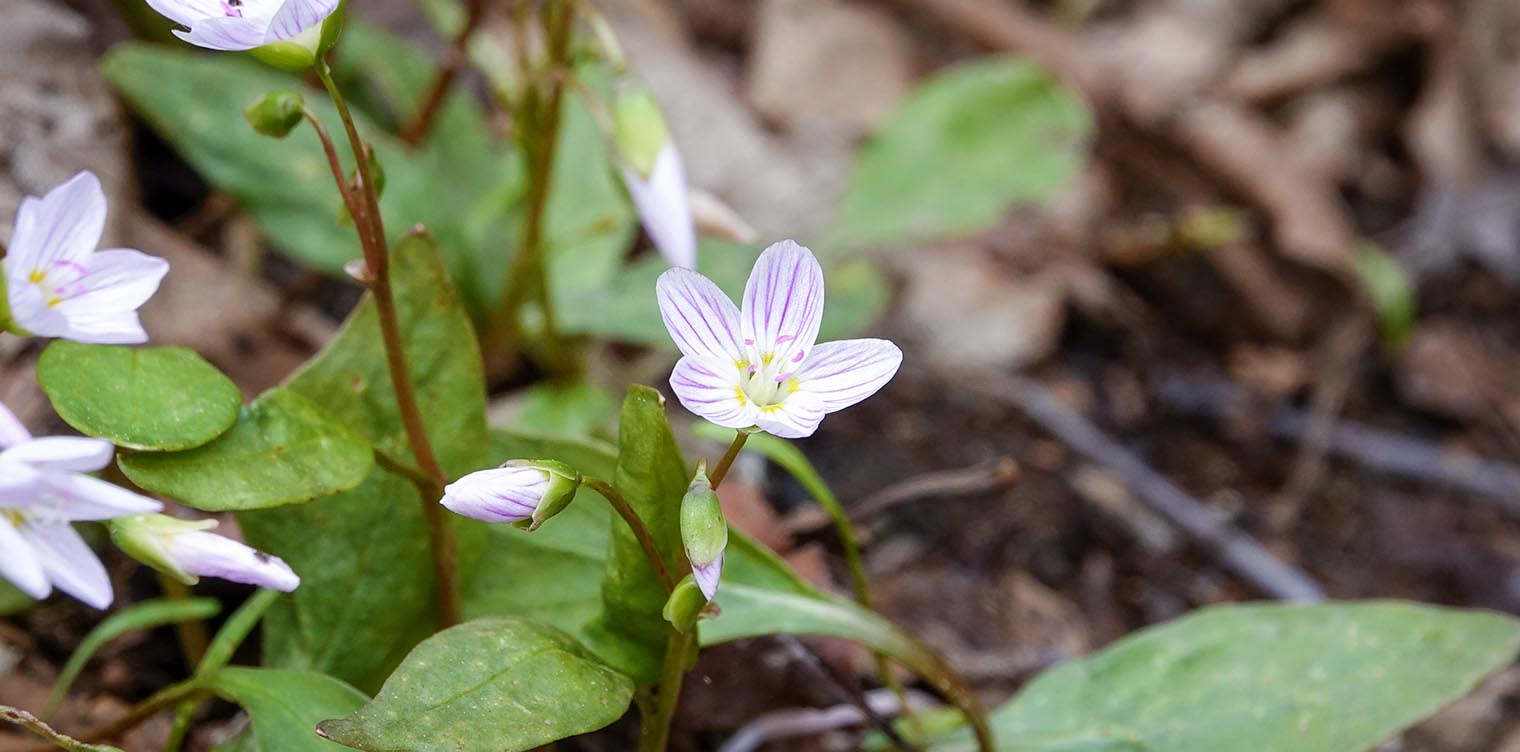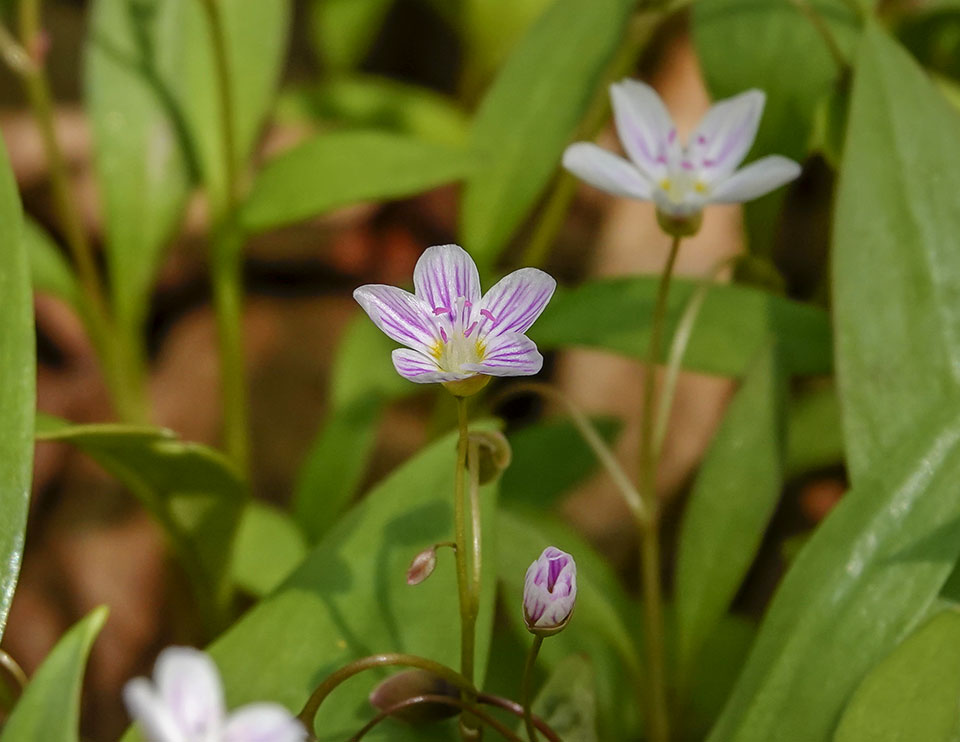Wildflowers of the Adirondacks:
Carolina Springbeauty (Claytonia caroliniana)

Carolina Springbeauty (Claytonia caroliniana) is a native wildflower that produces small pink flowers in early spring. It grows in forests and forest edges in deep rich mesic soils in the Adirondack Park in upstate New York.
Carolina Springbeauty is a member of the Purslane (Portulacaceae) family. The plant's scientific name is a reference to John Clayton, an 18th century botanist and one of the earliest collectors of plant specimens in what later became the Commonwealth of Virginia. Carolina Springbeauty is also known as Wide-leaved Spring Beauty and Carolina Spring Beauty.
Identification of Carolina Springbeauty

Carolina Springbeauty is a spring ephemeral – perennial woodland plants that sprout from the ground early each spring.
- Spring ephemerals quickly bloom and seed before the canopy trees overhead leaf out.
- Once the leaves of the canopy trees above have leafed out and the forest floor is deep in shade, the leaves of spring ephemerals wither away leaving just the roots, rhizomes, and bulbs underground.
This strategy allows spring ephemerals, like Carolina Springbeauty, Trout Lily, Dutchman's Breeches, and Squirrel Corn, to take advantage of the full sun hitting the forest floor early in the growing season.
Carolina Springbeauty is a tiny plant, generally under six inches in height. The leaves are medium green, about one to three inches long and about 3/4 inch wide. The leaves are broadly lance-shaped, tapering to a point at the tip and tapering at the base to an obvious leaf stem. The margins (leaf edges) are smooth. The leaves are opposite, meaning that they are attached to the stem in pairs.
The flowers are delicate and tiny, about half an inch wide, with five pink or white petals. The petals are accented with darker pink veins, giving the flower a candy-striped appearance. The flower has five stamens, each with a deep pink tip. Carolina Springbeauty is one of the earliest plants to flower in the spring. A tally of flowering dates compiled by Michael Kudish for the upland Adirondack areas, based on data collected from the early seventies to the early nineties, lists the earliest flower date as 16 April, the median date as 3 May, and the latest date as 21 May.
Carolina Springbeauty can be distinguished from a closely related plant which also occurs in the Adirondacks – Eastern Spring Beauty (Claytonia virginica L.) – by the shape of the leaves. Eastern Spring Beauty (also known as Virginia Spring-beauty) has very narrow leaves, in contrast to Carolina Springbeauty's much shorter and wider leaves.
Uses of Carolina Springbeauty
Carolina Springbeauty has very limited use as an edible plant. The roots, which are rich in starch, reportedly can be eaten raw or cooked like potatoes; and several native American groups are said to have used them for this purpose. The plant has no known medical uses.
Wildlife Value of Carolina Springbeauty
Carolina Springbeauty is of marginal wildlife value. Only the bulb-like corns serve as wildlife food; they are dug and consumed in spring by Eastern Chipmunks and White-footed Mice.
Distribution of Carolina Springbeauty
Carolina Springbeauty can be found in the eastern half of the US and Canada. Its range includes Nova Scotia to Ontario, south to New England, northern Michigan, and northeastern Minnesota. The plant also occurs in mountains south to Georgia, Alabama, and Arkansas.
In New York State, Carolina Springbeauty occurs in most of the counties in the eastern part of the state. This species is present in many of the counties within the Adirondack Park Blue Line, with the exception of Clinton, Lewis, Herkimer, and Fulton counties.
Habitat of Carolina Springbeauty
Carolina Springbeauty, like other spring ephemerals, grows under deciduous trees, since it relies on the early spring sunlight falling on the forest floor before the trees leaf out later in the spring. It prefers high humus.
Look for Carolina Springbeauty growing in rich mesic soils along trails, such as the Heron Marsh Trail and Logger's Loop Trail, that have sections winding through Northern Hardwood Forests. In the Adirondacks, this species is found mainly in two ecological communities: Beech-Maple Mesic Forest and Maple-Basswood Rich Mesic Forest.
References
Michael Kudish. Adirondack Upland Flora: An Ecological Perspective (The Chauncy Press, 1992), p. 23-28, 31, 42, 59, 127.
New York Flora Association. New York Flora Atlas. Carolina spring-beauty. Claytonia caroliniana Michx. Retrieved 19 March 2017.
United States Department of Agriculture. The Plants Database. Carolina Springbeauty. Claytonia caroliniana Michx. Retrieved 19 March 2017.
Flora of North America. Claytonia caroliniana Michaux. Retrieved 19 March 2017.
New York State. Department of Environmental Conservation. New York Natural Heritage Program. Ecological Communities of New York State. Second Edition (March 2014), pp. 119-120, 120-121. Retrieved 17 October 2015.
New York Natural Heritage Program. 2022. Online Conservation Guide for Maple-Basswood Rich Mesic Forest. Retrieved 31 March 2022.
New York Natural Heritage Program. 2022. Online Conservation Guide for Beech-Maple Mesic Forest. Retrieved 31 February 2022.
New York State. Adirondack Park Agency. Preliminary List of Species Native Within the Adirondack Park Listed Alphabetically by Scientific Name and Sorted by Habit. Volume 1. Updated 10.23.2006, p. 18. Retrieved 26 January 2017.
Connecticut Botanical Society. Carolina Spring Beauty. Retrieved 19 March 2017.
University of Wisconsin. Flora of Wisconsin. Claytonia caroliniana Michx. Retrieved 19 March 2017.
Lady Bird Johnson Wildflower Center. Claytonia caroliniana. Retrieved 19 March 2017.
Online Encyclopedia of Life. Claytonia caroliniana - Michx. Retrieved 19 March 2017.
David M. Brandenburg. Field Guide to Wildflowers of North America (New York, NY: Sterling Publishing Company, Inc., 2010), p. 439.
Mark J. Twery, at al. Changes in Abundance of Vascular Plants under Varying Silvicultural Systems at the Forest Ecosystem Research and Demonstration Area, Paul Smiths, New York. USDA Forest Service. Research Note NRS-169, p. 7. Retrieved 22 January 2017.
Alexander C. Martin, Herbert S. Zim, and Arnold L. Nelson. American Wildlife & Plants. A Guide to Wildlife Food Habits (New York: Dover Publications, 1951), pp. 261-262.
John Eastman. The Book of Forest and Thicket: Trees, Shrubs, and Wildflowers of Eastern North America (Stackpole Books, 1992), pp. 180-181.
Plants for a Future. Claytonia caroliniana - Michx. Retrieved 19 March 2017.
University of Michigan. Native American Ethnobotany. A Database of Foods, Drugs, Dyes and Fibers of Native American Peoples, Derived from Plants. Claytonia caroliniana Michx. Carolina Springbeauty. Retrieved 19 March 2017.
Charles H. Peck. Plants of North Elba. (Bulletin of the New York State Museum, Volume 6, Number 28, June 1899), p. 82. Retrieved 22 February 2017.
Doug Ladd. North Woods Wildflowers (Falcon Publishing, 2001), p. 93.
Lawrence Newcomb. Newcomb's Wildflower Guide (Little Brown and Company, 1977), pp. 270-271.
Roger Tory Peterson and Margaret McKenny. A Field Guide to Wildflowers. Northeastern and North-central North America (Houghton Mifflin Company, 1968) pp. 238-239.
National Audubon Society. Field Guide to Wildflowers. Eastern Region. (Alfred A. Knopf, 2001), pp. 707-708.
William K. Chapman, et al. Wildflowers of New York in Color (Syracuse University Press, 1998), pp. 20-21.
Donald J. Leopold and Lytton John Musselman. Wildflowers of the Adirondacks (Johns Hopkins University Press, 2020), pp. 197-198.
Anne McGrath. Wildflowers of the Adirondacks (EarthWords, 1981, 2000), p. 26, Plate 13.
"John Clayton (1695-1773)," Encyclopedia Virginia. Retrieved 24 January 2018.
